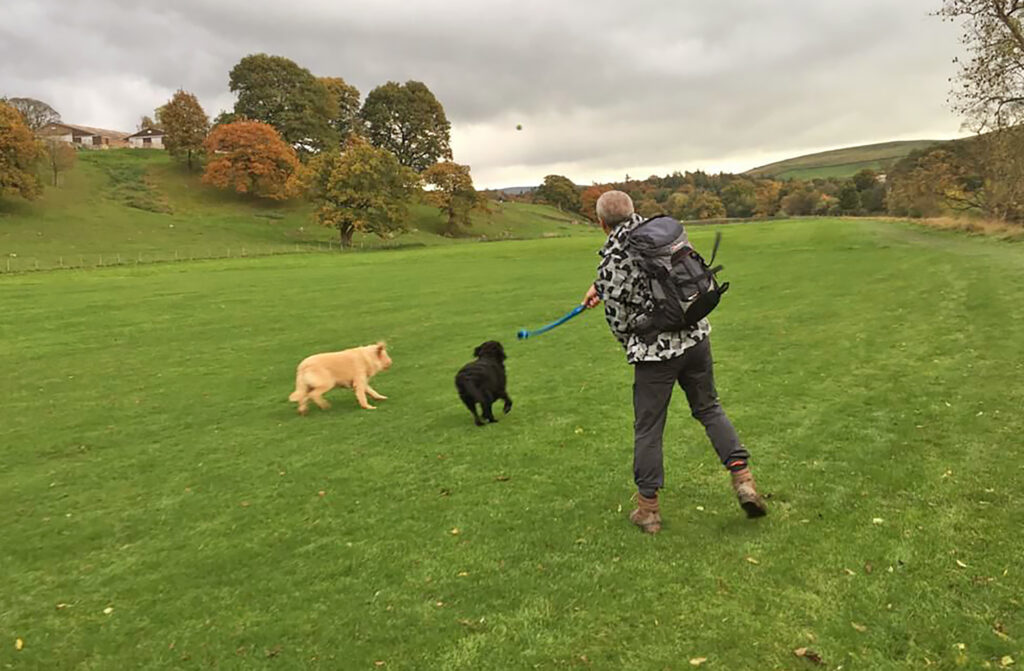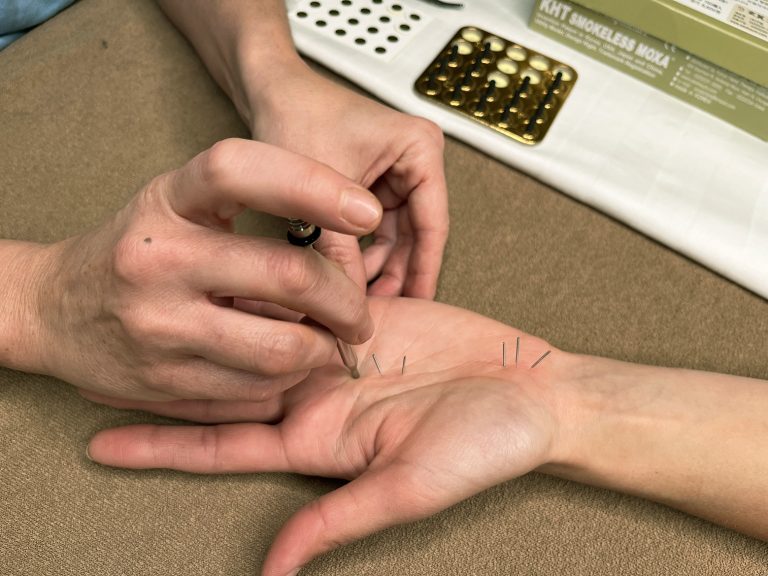Paul’s Testimonial is a truly inspiring story for anyone that picks up an injury that could be life-changing…
‘I thought a good time to give you my testimonial would be at the point that I am able to get back on my bike, which is today. I know we still have a journey ahead but I am deeply grateful and I hope what’s below can be of use to other people.
Taking you by surprise
The first time you experience it, ‘Saddle Anaesthesia’ is quite alarming. It’s like sitting in a warm bath while you are still standing, at first, then you quickly lose all sensation in the skin everywhere in the saddle area, which is more or less the surfaces that would be in contact with a saddle when on horseback. Up until that point, all I had experienced was pain in relation to the issues I’d been experiencing with my back for many years, so losing feeling in my legs like this was quite scary. This loss of feeling was still accompanied by the familiar chronic pain in my lumbar muscles higher up, although this time the sensation in the muscles escalated to a sharp, searing pain at the same time as the numbness set in lower down. Instinctively I squatted, or more accurately I was forced to squat, as my legs had already started to give way. This was a step change from a bout of spasm and pain in my lower back that had set in a few days earlier. Somehow, I managed to crawl home, which was luckily only about a hundred yards away. Much later I learned that this was the result of a large prolapse of the L4/5 disc.
Traditional remedies
I was first seen by an Osteopath for my lower back issues in 1997 when I was working for a wholefood company and lugging around sacks of rice, kidney beans and flour all day. Prior to that I’d not been a stranger to hard labour as I moved from job to job. Being 6’4″ tall, young and not particularly physically conscious at that time, I soon developed a hinge point in my lower back that appears to be the source of much of my chronic back pain to date. But it seems that accurate diagnosis is the most difficult aspect of this problem, at least for the NHS which I now refer to as the National Harm Service. Don’t get me wrong, I love what the NHS stands for. For basic stitching and fixing it would be my first port of call. But the pill-popping prescription culture is more of a problem than a solution and serves mainly to fund the big pharmaceutical companies that appear to have taken control of an institution that was originally a great source of national pride. All the various disciplines are fragmented off and you are passed from one specialty to another, with none of them properly talking to each other about the patient and none of them looking at the bigger picture. For me, the NHS has always done more harm than good – but that is another story.
I am actually profoundly grateful for the incompetence of the GP who neglected to immediately order a scan when I originally described my saddle anaesthesia the following day when I appeared at the surgery. These are ‘red flag’ symptoms but perhaps I offended the female GP when I told her she was not sticking her finger up my behind to check my sphincter and would have to take my word for it that I hadn’t lost control of my bladder or bowel. With ‘red flags’ the scan is usually the holy grail of diagnosis and the first port of call, but all I got from the NHS that day was a referral for a telephone assessment with a Physiotherapist and a repeat prescription of optiates and benzos. If she had done her job, I would have been for a scan immediately and in that weak and vulnerable state I wouldn’t have resisted the recommended treatment of surgical lumbar decompression. She did me a huge favour. My problem was eventually described as ‘cauda equina compression’ when I finally got a scan some seven weeks later and surgery seems to be a frequent response to this diagnosis. It sounds pretty serious when you read up on it, but I’d already learned to be brave enough to question the authority of so-called ‘experts’. Believe me, however serious it seems at the time, and whatever your GP, Physiotherapist, Radiologist, or Consultant tells you, there is often an alternative that works better than conventional medicine for back problems…and many other health issues.
Experiencing the NHS
Ironically, if I wasn’t already doped up with prescription drugs I might have had better warning of how bad things were getting before that night when I was walking my dogs, but instead the first I knew of how severely things were progressing was to lose use of my legs. If I believed in God, I would thank her for the serendipity of being failed by the NHS who sent me home bent double instead of ordering an ambulance, but most of all I would thank her for the fact that I was already familiar with the skill and knowledge available from Mr Errol Lynch. I am in no doubt that he is the reason I am now able bodied and functioning without having suffered the dubious ‘benefits’ of surgery. I was terrified at the time. I had never lost use of my legs before and as the next few days progressed, I was aware I had almost no sensation in my lower limbs and the circulation was very poor. Basically, the usual nerve communication with my legs had been compromised. I couldn’t properly signal to my legs to walk, and they couldn’t signal to my central nervous system for the purposes of blood supply or temperature regulation. My leg muscles were like flaps of dead meat.
Finding Touch Tuina
I am indebted to Errol for being available to treat me, because I know his skills are in demand. Until I was able to get a taxi to the treatment centre, he came to my home to work his magic. But it isn’t really magic, it’s common sense and in my opinion Tuina is not ‘complementary’ medicine at all – it’s more credible than any approach available on the NHS. What does a Tuina practitioner do when someone has loss of nerve function due to lumbar compression and the blood is no longer moving? They work on the nerves and move the blood. What do the NHS do? either nothing, or immediate surgery! None of the front-line points of contact in the NHS will dare to even commit to an opinion on what you should or shouldn’t do, let alone give you immediate treatment, unless you have been elaborately assessed, poked, prodded and scanned. That process would have happened far too late to help in my case and luckily, I had other weapons in the arsenal to fight this sudden onset of disability. Not everyone is so lucky.
Having suffered for a lot of years with back pain I had already informed myself about the standards that are used to measure medium and long term ‘success’ in surgical interventions for various conditions of the lumbar spine. It seems pretty hit and miss to me. I also believe in a holistic approach to any health issue and Errol treats the whole being, working with Qi, blood, muscles, nerves and ligaments. For the first few weeks I was close to being completely helpless and dependent on family as I tried to ignore the pressure to consider surgery from people who have already been down that route. It was a very anxious time and along with Errol’s help, I was tackling it with meditation and positive thinking to try and rally my body’s capacity to heal. When I finally saw a Physiotherapist at the 5 week point, my foot reflexes were still not back and my walking was still very limited. I was hobbling like a thunderbirds puppet.
Avoiding surgery
My left leg at that time was weakest and I couldn’t stand on my tiptoes as there was no response from my left foot. Every day the blood would stagnate in my legs and my calves and feet would become cold and numb. Eventually I saw a more competent and thorough GP and a scan was ordered. Neither the Physio nor the GP would advise on what I should or shouldn’t do without sight of a scan result; later on, they wouldn’t commit at the point of seeing the scan either, because they then wanted a consultant’s opinion. This was because the Radiologist had said the scan required immediate attention, ringing some alarm bells.
The GP called me the same day he got the scan result, warning me to be prepared to go to hospital. For the whole 7 weeks up until that point when the scan result prompted a sense of urgency, the NHS had done nothing proactive. Meanwhile Errol was bringing my legs back to life with his multidisciplinary approach.
When the GP saw me to discuss the scan, my physical state didn’t correspond to the alarming opinion of the radiologist. Strength was returning to both legs and I could now stand on tiptoes with each foot separately. My walking range was increasing steadily. I was not supposed to be in this condition according to the scan, and without Errol’s help I am in no doubt that I wouldn’t have overcome the atrophied muscles and loss of nerve function in this way. When he saw how I had improved, the GP revised his advice on possibly needing to go to hospital immediately and I went on the waiting list for a neurosurgical opinion – not that such an opinion would divert me from my course of treatment with Errol; it would just be for information purposes.
The Touch Tuina experience
I consider myself privileged to be in a position to undergo intensive treatment in Errol’s care. The approach of three one-hour sessions a week in the early stages undoubtedly brought me back from the brink of surgery. Errol estimated 3-6 months in total to regain full strength and return the nervous system to proper function and as I write this at the halfway point, it seems to be so. Motor signals, sensation and blood flow have all improved massively and I dread to think of how I might have suffered without the knowledge that Tuina could help.
A typical NHS patient in my condition – if they escaped immediate surgery – would have had no hands-on treatment from the litigation wary disciplines on offer. In my case it was impossible to get the Physiotherapist to commit to recommending any kind of exercises and I only got vague answers to my questions while they waited for someone higher up the food chain to decide what to do. No deep tissue massage or hands on Physiotherapy was offered to keep the muscles and blood flow working. Nothing would have been done to restore nerve function. In fact, most of what Errol is capable of is unrecognised by conventional medicine.
I would have been in a sorry state indeed and it makes me angry for all the tax paying citizens who are often advised against alternatives and categorically told that they don’t work. Tuina works phenomenally well because of its common-sense approach of treating the whole body-mind system in a holistic way. It’s also a very economical alternative to the cost of conventional medicine. At this point I’ve used less of my savings than I would have spent on a couple of holidays, so even paying privately, it’s a small cost to have someone so comprehensively restore my body. And that is what Errol has done, systematically reversing the bad muscle memories, breaking down scar tissue, removing adhesions, strengthening the nerves, moving the blood and getting my Qi in order. And for anybody who needs convincing that Qi is a real and powerful life force coursing through the body, help is at hand. Any of the skilled practitioners trained by Errol can quickly demonstrate this energy in your body so that you can feel it for yourself.
There is another way…
Even the lumbering leviathan of conventional scientific opinion is slowly moving towards acceptance that there is such a thing as an energy body that is just as real as the physical one. Working with that energy and with all the other interdependent body-mind systems, Tuina and TCM bring thousands of years of knowledge and understanding to the table. I feel almost evangelistic about Tuina because it has saved me from surgery and given me hope of returning to a fully active physical lifestyle. This is after years of chronic lower back pain which forced me to give up running and my beloved pastime of mountain biking.
As I write, I am already back on my bike taking gentle exercise and I’m able to enjoy a bit of rough and tumble with my enthusiastic and slightly mad dogs. The power of Tuina to turn things around in the early stages when I was quite disabled brought tears of relief and release streaming down my face. In the darkest, most painful part of this frightening failure in my body, I knew I was in good hands and that I’d found the person who could help me, who gave me hope, and who could help me to help myself.
It’s not a miracle cure – it’s the application of wisdom that science and conventional medicine cannot yet accept due to tunnel vision. The human body is an incredibly complex matrix of interdependent systems. Until conventional medicine understands and embraces this, instead of obsessing with a single physical or chemical cause that they can shoot a single magic bullet at, we will always have a National Harm Service and not a National Health Service.
Gratitude
In my opinion, Errol Lynch has an intellectual and intuitive grasp of the human system that is beyond anything you will encounter in the NHS and beyond most other holistic practitioners in terms of knowledge, skill and experience. I am deeply grateful and honoured that I am in his care and I cannot speak highly enough of that care. For any number of illnesses, his approach can provide concrete, verifiable resolution that dramatically improves quality of life. Such mastery is a rare thing.’
We were very touched to read Paul’s Testimonial. It eloquently highlights that there is often another way of looking at your route back to health following an injury of medical incident. If you are experienceing an issue that you’re struggling to find the answers to, why not get in touch to find out if we could help you too.





